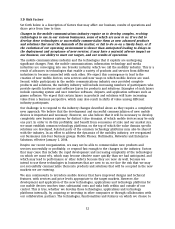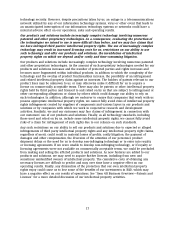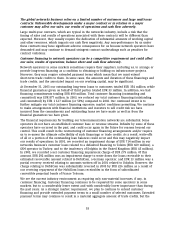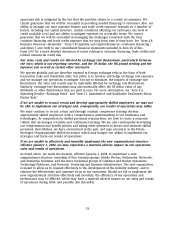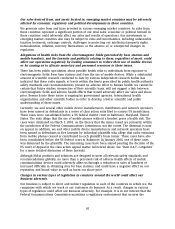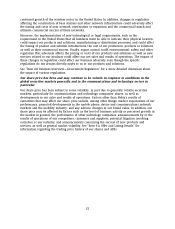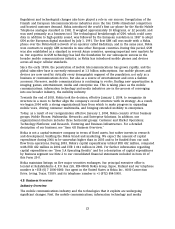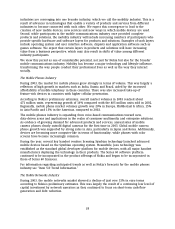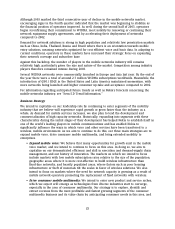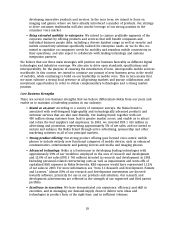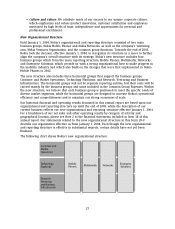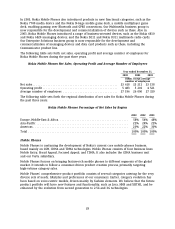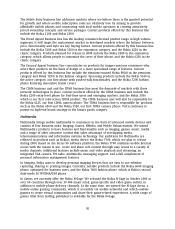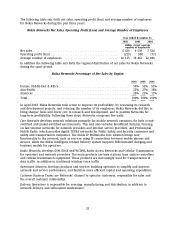Nokia 2003 Annual Report Download - page 23
Download and view the complete annual report
Please find page 23 of the 2003 Nokia annual report below. You can navigate through the pages in the report by either clicking on the pages listed below, or by using the keyword search tool below to find specific information within the annual report.ITEM 4. INFORMATION ON THE COMPANY
4.A History and Development of the Company
Nokia is a world leader in mobile communications, contributing to the growth and sustainability
of the broader mobility industry. Nokia is dedicated to enhancing people’s lives and productivity
by providing easy-to-use and secure products like mobile phones, and solutions for imaging,
games, media, mobile network operators and businesses. For the 2003 financial year, Nokia’s net
sales totaled EUR 29.5 billion (USD 37.1 billion). At the end of 2003, we employed 51 359 people
and had production facilities in nine countries, research and development centers in 11 countries
and sales in over 130 countries, and a global network of sales, customer service and other
operational units.
During our 138-year history, Nokia has evolved from its origins in the paper industry, to become a
world leader in mobile communications. In 1967, we assumed our current corporate form as
Nokia Corporation, a corporation under the laws of the Republic of Finland. This took place
through the merger of three Finnish companies: Nokia AB, a wood pulp mill founded in 1865
which took its name from the nearby Nokia River, Finnish Rubber Works Ltd, a manufacturer of
rubber boots, tires and other rubber products founded in 1898, and Finnish Cable Works, a
manufacturer of cable for power transmission and telegraph and telephone networks founded in
1912.
Nokia entered the telecommunications equipment market in 1960 when an electronics department
was established at Finnish Cable Works to concentrate on the production of radio transmission
equipment. This was a period in which Nokia diversified in other industries as a hedge against
economic cycles.
In the 1980s, we strengthened our position in the telecommunications, consumer electronics and
personal computer markets. We introduced the first fully digital local telephone exchange in
Europe in 1982, and the world’s first car telephone for the Nordic Mobile Telephone analogue
standard that same year. Since then, Nokia has introduced mobile phones across all major cellular
standards. In 1987, we acquired the consumer electronics operations and part of the components
business of Standard Elektrik Lorenz of Germany, as well as the French consumer electronics
company, Oceanic. At the beginning of 1988, Nokia became the largest technology company in the
Nordic region, after the purchase of Ericsson’s information systems division.
In the early 1990s, we made a strategic decision to make telecommunications our core business,
with the goal of establishing market leadership in every major global market. Basic industry and
non-telecommunications operations including paper, personal computer, rubber, footwear,
chemicals, power plant, cable, aluminum and television businesses, were divested during the
period from 1989 to 1996. Having decided to concentrate on telecommunications as our core
business, our organizational structure evolved to consist of two main business groups, Nokia
Mobile Phones and Nokia Networks. A venturing arm called Nokia Ventures Organization was later
created to foster new businesses. Over the course of the decade, the relative financial contribution
of the two main business groups fluctuated. However, by the end of the 1990s, Nokia Mobile
Phones came to represent the largest part of our business, and together with Nokia Networks
accounted for substantially all of our net sales.
Finland’s competitive business climate and emphasis on innovation have contributed to our
success. From the beginning of the telecommunications era, there have been several
telecommunications operators in Finland. These companies were not required to purchase
equipment from national suppliers, providing a spur to competition in the domestic market. The
need to export products to other markets to achieve growth encouraged us to develop our
business and products in an international environment and build a leading competitive position.
22


